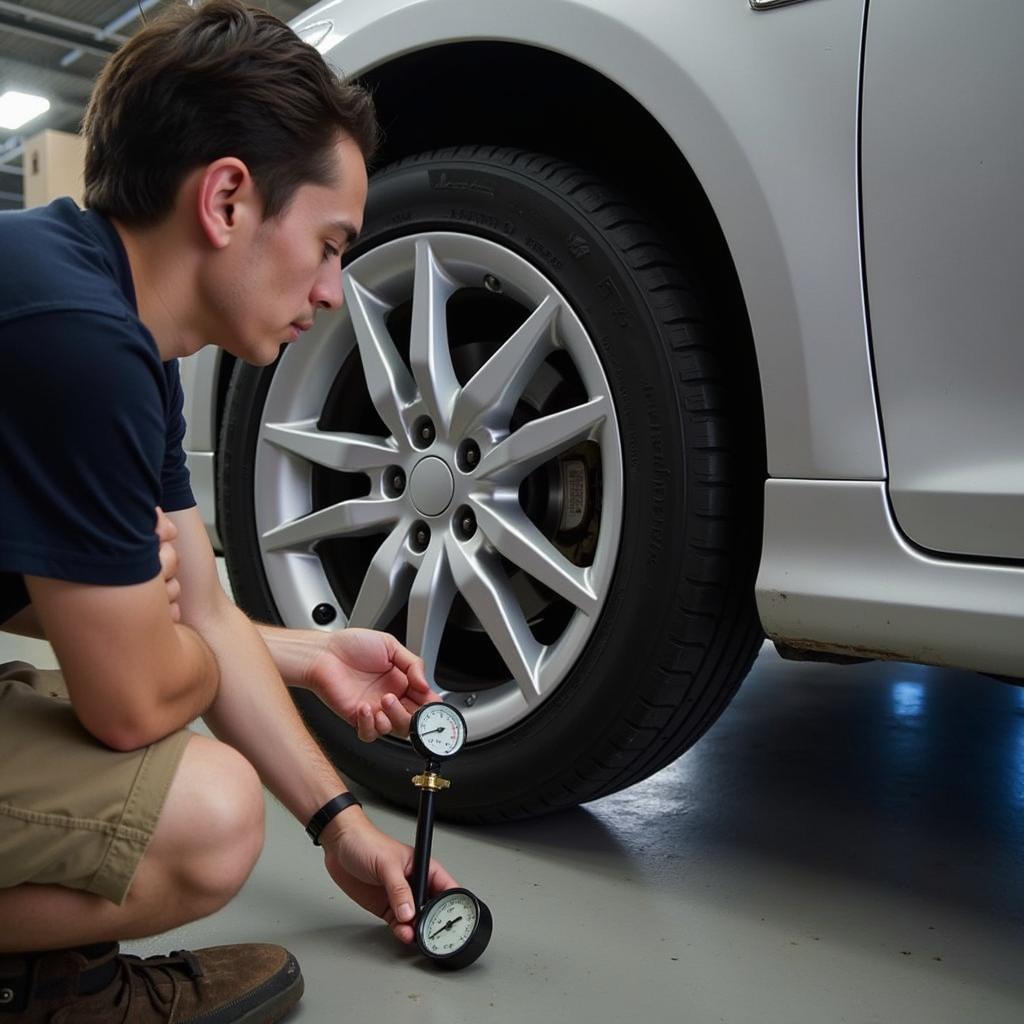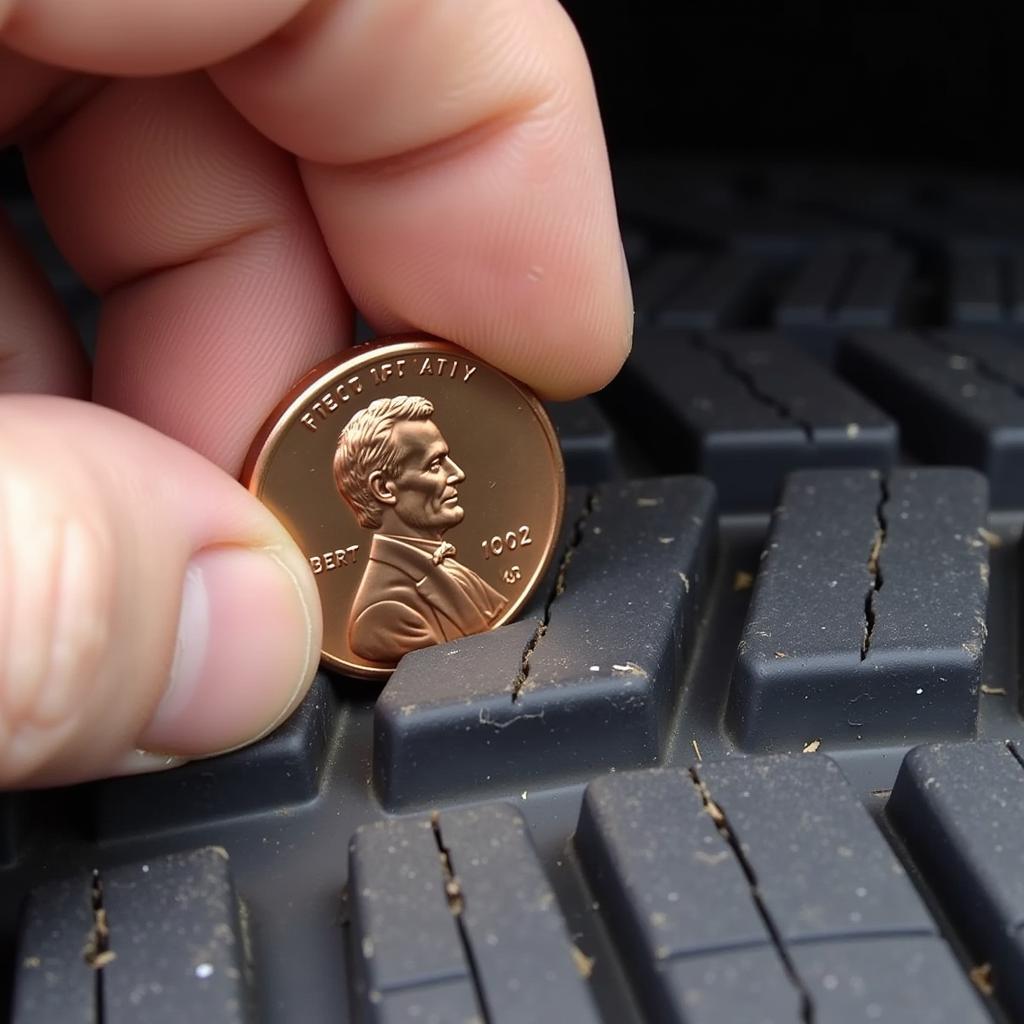Basic car maintenance is crucial for every car owner, ensuring safety, reliability, and longevity. This comprehensive guide will empower beginners with essential knowledge and practical tips to keep their vehicles in top condition. Learn the basics and save money by avoiding costly repairs down the road.
 Checking Tire Pressure with a Gauge
Checking Tire Pressure with a Gauge
Maintaining your car doesn’t have to be intimidating. Many essential tasks are surprisingly simple and can be performed at home with a few basic tools. This guide covers Basic Car Maintenance For Beginners, including checking fluids, inspecting tires, and understanding warning lights. We’ll break down each task into easy-to-follow steps, ensuring you feel confident taking care of your car. You can find a lot of helpful resources online, like articles on types of diy car maintenance.
Essential Fluid Checks for Beginners
Regularly checking your car’s fluids is fundamental to basic car maintenance for beginners. It prevents potential problems and keeps your car running smoothly.
Engine Oil: The Lifeblood of Your Car
Engine oil lubricates the engine’s moving parts, reducing friction and heat. Check the oil level using the dipstick, ensuring it’s within the recommended range. The oil should also be a light brown color; dark, gritty oil indicates it’s time for a change.
Coolant: Keeping Your Engine Cool
Coolant prevents the engine from overheating. Check the coolant level in the reservoir when the engine is cold. Ensure it’s between the minimum and maximum marks.
Brake Fluid: Essential for Safe Stopping
Brake fluid transmits pressure from the brake pedal to the brakes. Check the brake fluid level in the master cylinder reservoir. If the level is low, it could indicate a leak in the brake system.
Tire Maintenance: More Than Just Air
Proper tire maintenance is essential for safety and fuel efficiency.
Checking Tire Pressure
Use a tire pressure gauge to check your tire pressure regularly. Maintain the recommended pressure listed in your owner’s manual or on the sticker inside the driver’s side doorjamb. Proper tire inflation improves fuel economy and handling. What is the best way to check tire pressure? Always check tire pressure when the tires are cold for the most accurate reading.
Inspecting Tire Tread Depth
Sufficient tread depth is crucial for grip and traction, especially in wet or snowy conditions. Use a penny to check the tread depth. If you can see Lincoln’s head, it’s time for new tires. For a list of DIY maintenance projects, you can refer to 30 diy car maintenance projects.
 Inspecting Tire Tread Depth with a Penny
Inspecting Tire Tread Depth with a Penny
Understanding Warning Lights: Your Car’s Way of Talking
Your car’s dashboard warning lights provide valuable information about its health. Familiarize yourself with the meaning of each light and take appropriate action when one illuminates. Ignoring warning lights can lead to serious problems.
- Check Engine Light: This light can indicate a range of issues, from a loose gas cap to a more serious engine problem. Get the code read at an auto parts store or repair shop to diagnose the problem.
- Oil Pressure Light: This light indicates low oil pressure, which can cause serious engine damage. Stop driving immediately and check the oil level.
- Brake Warning Light: This light can indicate low brake fluid or a problem with the braking system. Have your brakes inspected immediately.
Basic Car Maintenance Schedule for Beginners
Creating a simple maintenance schedule can help you stay on top of essential tasks and prevent costly repairs. For those interested in formal training, check out a basic car maintenance course auckland.
- Every Month: Check engine oil, coolant, and brake fluid levels; inspect tire pressure and tread depth.
- Every 3 Months/3,000 Miles: Replace engine oil and oil filter.
- Every 6 Months/6,000 Miles: Rotate tires, inspect air filter, check belts and hoses.
- Every Year/12,000 Miles: Inspect and replace spark plugs, check battery, inspect and flush cooling system.
“Regular maintenance is the key to keeping your car running smoothly and avoiding expensive repairs down the line.” – John Davis, Automotive Engineer
“Don’t underestimate the importance of checking your tires. Proper tire pressure is crucial for safety and fuel efficiency.” – Maria Sanchez, Certified Mechanic
Learning basic car maintenance can lead to significant savings. Explore the potential benefits of DIY maintenance with do it yourself car maintenance yearly savings. For further reading, consider checking out some helpful car maintenance for beginners books.
Conclusion
Basic car maintenance for beginners is not as daunting as it may seem. By following these simple steps and staying proactive, you can keep your car running smoothly, save money on repairs, and ensure a safe driving experience. Remember, regular maintenance is the key to a happy and healthy car. Feel free to contact AutoTipPro at +1 (641) 206-8880 or visit our office at 500 N St Mary’s St, San Antonio, TX 78205, United States, for any further assistance or questions.




Leave a Reply